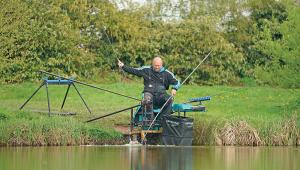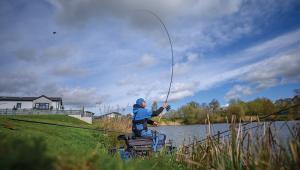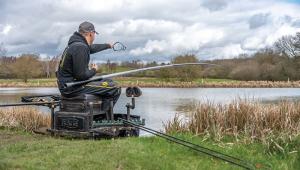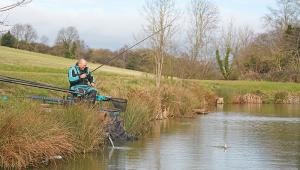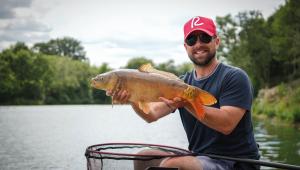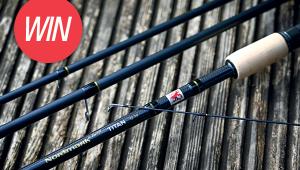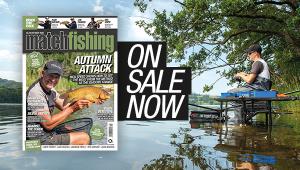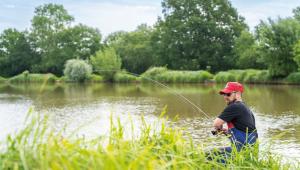Refining The Crude

With recent heavy rain and many rivers in flood, bream have come to the fore. The last few matches at Medley have been won with weights of 50 to 60lb of good sized bream, but the interesting thing is that the pole feeder has been outscoring both flat floats and the conventional feeder.
One angler who thinks he knows why is Steve Harwood. A master of many a method, he has agreed to reveal to us just what it is about the pole feeder that makes it so deadly and what you need to know to get the most out of it?
Why Pole Feeder?
Flat floats are very much the rage when it comes to flooded rivers. Although they do have their place, really it’s their use in Float World Championships that makes them so popular.
In the Worlds, the feeder is banned so big flat floats are the next best thing; that doesn’t mean they are necessarily correct, however. I’m sure that faced with the need for a 30g flat float, in most situations a pole feeder would be loads better!
Flat floats are great up to around 10g, but much more than that the pole feeder offers far better presentation. With the feeder, you know your bait is properly nailed exactly where you want it. Even with a bit of wind and some movement on the pole, the feeder remains static, while a flat float would start to bounce about and cause your hook bait to do the same.
Not only that, but as flow and conditions change, you might need to change the size of flat float needed throughout the session. You just don’t need to do that with the pole feeder, as the most you will have to do is unclip your feeder and put another on.
The other option you have is to fish a conventional feeder, but with the water freezing cold at this time of year, you just cannot beat the accuracy of the pole and being able to fish in a very tight area. Even in very high conditions, bream will still back off down the peg and you have to draw them back up. If you chase them down, all they will do is disappear further and further downstream before you lose them completely.
Location
With all the extra flow and colour in a river, fish feed very differently. They can no longer see where they are and the only way they can find their way around is by using the only fixed point of reference left – the riverbed. This means if fish are going to feed at all, it will always be right tight to the bottom.
With the water moving so fast, they will also want to be out of the main flow. I’m not talking static water, just water with a reasonable pace but out of the full brunt of it. Any peg where the water slackens off a bit close in is ideal for the pole feeder. If that slack water is on the far bank, the conventional feeder cast into it is your only option of course.
The other key point to remember is the river also needs to be heavily coloured, high and rising. In these conditions, the big ugly fish will feed and the pole feeder is at its best. Once the river starts clearing and fining down, the bigger fish shut up shop and more conventional river tactics are better.
Plumbing Up
This might sound a bit strange, but to make it work you’ve got to plumb up the pole feeder correctly. I do this by clipping a large bomb on to the rig where the feeder would go and working my way out into the river. The exact distance to fish needs to be right near the main flow, but not quite in it. You also need to be feeling for snags and obstructions on the bottom. With the river high, you don’t know what you’re fishing on as you could be about to feed on top of what would normally be marginal weed. The only way to make sure the peg is clear is by dragging the bomb around.
Once distance has been decided, the rig needs to be shortened. My aim is for the rig to be heading down the peg at around 45 degrees. You could fish with the rig going straight down, but to see a bite effectively would mean the fish would have to pull down, which when it is already on the bottom is impossible of course. With the rig at 45 degrees you will either get a positive pull under or a drop back as the fish moves along the bottom.
Seeing Bites
Bite indication is also very important. People seem to think that the pole will simply wrap round but it doesn’t. If you fish like this, you will catch very little. There are elastic pole feeder indicators on the market, but I have made my own. I cut the top off a (non-insert) crystal waggler and drill a small hole in the top end. I then pull some No5 elastic through the hole and knot the end to stop it pulling back out. About 18 inches above the float top I then tie a loop in the elastic and cut the rest off. Dacron connectors are all the rage, but my top kit for the pole feeder is a standard plastic connector. This is so I can put the loop of the No5 elastic and the loop on the top of my rig on to it. The hollow float top is then held to the line two feet further down the rig by big float rubbers. Because the indicator is two feet down the rig but the elastic only 18 inches long, when relaxed it creates a 6in loop of slack line. This gives the elastic the freedom to stretch and the float top to move, indicating a bite.
I won’t be playing the fish on this piece of No5 elastic of course, because as soon as it has stretched just six inches, the line is tight and I am back playing the fish on the rig. The indicator is parallel to the rig, not in series with it, remember. To see this up close, take a look at the Feature+ video attached to this feature by scanning the QR code with the camera app on your phone. Bites can be anything from proper guzunders right through to the float top just bouncing about a bit. Either way, a firm upward strike is the result.
Proper Gear
You’re far braver than me if you attempt to fish this method with a normal pole! Strong line, heavy flow and big fish are a recipe for breakages. I use a margin type pole with a minimum 14-rated elastic. It’s not just bream, as there is always a chance of hooking a barbel, and if I’m lucky enough to hook one, I want to land it!
Main line is 6lb Guru Pulse. I tie a 5in loop in the bottom of it to create a paternoster. I connect a snap-link swivel to this via loop to loop then tie a small loop in the tag end to attach my hooklength. This will then be 18 inches of 0.16mm Supplex to a size 12 Gama 2210. If faced with mega-fast water, I will change this to a running rig as this is stronger due to not having the loop in the middle. My preference is the paternoster though, as this definitely shows up bites better.
There are two types of feeder that I use. A cage feeder can be good for slower water as it creates a bit of cloud, but normally a taped-up feeder is best as I want a slow release and all of my feed on the deck. Normally, 30g to 50g feeders are heavy enough, even in water that would be too fast for a 50g flat float to sit right.
Feed Them!
Fishmeal groundbait is great for bream, but because I’m going to be feeding quite a lot, I usually cut it with 50 per cent of some leftover roach mix from the freezer. The Thames can be a funny place and I will regularly expect to use 3kg of groundbait in normal conditions but end up taking half of it home. Rather than waste it, it goes in the freezer for just these conditions.
With the bait now being a bit older and the activity killed by the freezer, it will now be far more dormant on the bottom. The last thing I want is active particles drifting off and dragging fish away.
With the water now being even colder after some chilly nights, I’ve cut the fishmeal down to just 30 per cent for my initial feed. I keep my grounbaits separate so I can change this quantity. If I get a good response to the feed, I will up the fishmeal to 50 per cent for my top-up mixes. My choice of fishmeal groundbait is equal quantities Ringers Dark, Ringers Original, Tom Thick Green and Tom Thick Black.
Bait that goes into the initial feed are the usual worms, dead maggots and casters but what might surprise you is the inclusion of lobworms. They might be an unusual feed for bream, but they actively hunt them on a flooded river. As the water level drops, you see a lot of dead worms on the banks that have drowned in the rising water. Many of these end up the water and fish know to look for them! As soon as floodwater gets as high as the grass, you can be sure that lobworms will start working well both as feed and on the hook. Ten big balls are made up, skinned with water to stop them clouding and thrown in. I have my pole in the rest while doing this so I get the distance correct and choose a far-bank marker for accuracy.
To get the rig into the peg, a cable tie on the pole is a big help. I loop the rig over the tag when shipping out, which allows me to get the rig out without dragging the feeder through the water. I then ship out and turn the pole over to release the feeder while lifting the pole up. Once the feeder has stopped swinging, I can lower it down the hole. This is done just upstream of the marker to compensate for the 18in hooklengeth and the pole is then carefully put in the rest upstream with line going down at 45 degrees. Every few minutes, I will bring the feeder in and reload it.
Final Tips
A variety of hook baits can work, but big ones like the tail of a lobworm or top and tail of a dendra will always be my first choices. The important thing to remember is that fish will be finding it difficult to find your bait in the water. You are relying on the smelly fishmeal and the noise of balling in to draw them it. If nothing happens, throwing in the odd ball even if you feel you have already fed enough can work, as the noise can draw fish in.
The Session
With a few cold nights in the lead-up to the feature, I wasn’t expecting the fishing to be quite as good as previous weeks, but was still hoping for 50lb. Despite yet more rain last night, for some strange reason the flow actually calmed throughout the day and the colour started to drop out, which as I mentioned earlier, is not what you want for bream!
I did however manage four bream and a hybrid for 20lb, which is a good winter weight on most rivers, let alone the Thames. The pole feeder is an awesome method and to do it properly requires a bit of thought. Some people turn their noses up at it, but ignore it on its day and you will get beaten!
- Log in or register to post comments

